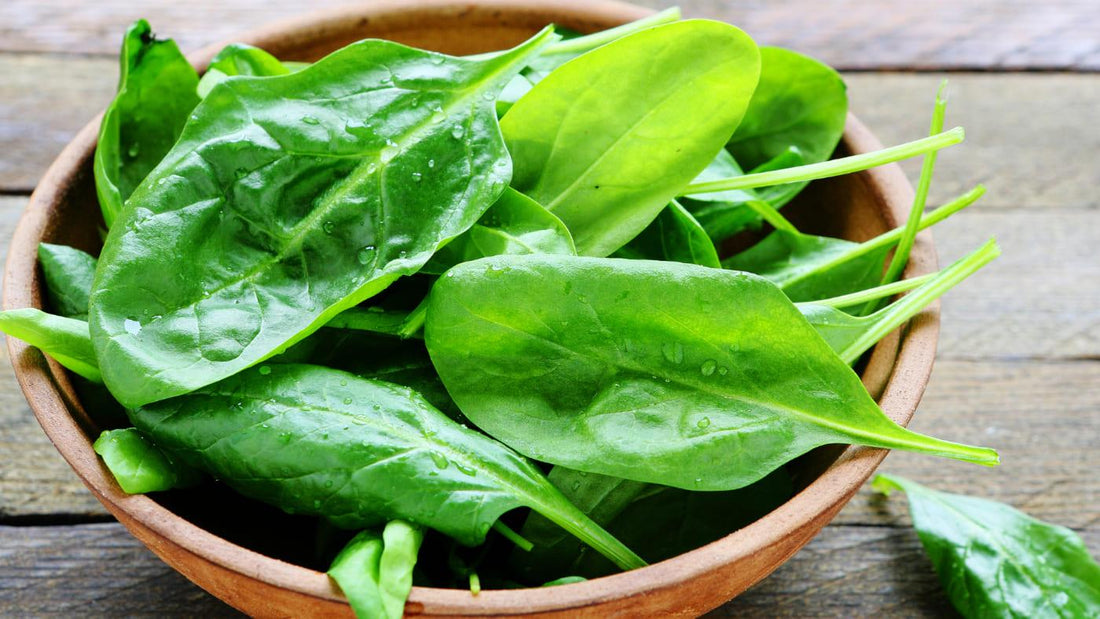This classic leafy green vegetable is the epitome of the term superfood. Rich with antioxidants, and packed full of essential vitamins and minerals, spinach is one thing you don’t want to leave out of your diet.
Spinach is a part of the Amaranthaceae family, along with beets, chard, and quinoa. It originated in Persia but spread to China as a gift from the king of Nepal in the 7th century. In the 11th century, spinach was introduced to Europe.

By 1533, spinach had become a staple of French cuisine when Catherine de Medici, the bride of Henry II, claimed that spinach was one of her favorite foods. Since then, any meal containing spinach was dubbed ‘a la Florentine’ out of respect for Catherine’s birth city, Florence.
It wasn’t until the early 1800s that spinach became a common crop in the US, however it was somewhat of an undesirable vegetable until Popeye the Sailorman’s comic strip debuted in 1929, making spinach all the rage.
Today, spinach is one of the most popular vegetables in the world. Being high in nutritional value and low in calories makes it a favorite among those trying to improve their diets, and its mild flavor lends itself to a plethora of delicious meals you won’t be able to turn down.
The Top Health Benefits of Spinach

Spinach prevents hypertension
Hypertension, also known as high blood pressure, is a condition in which the artery walls expand, making it harder for blood cells to pass through. That increased pressure in the arteries can lead to stroke, aneurysm, and heart failure, and is often caused by diets with high levels of sodium.

Hypertension is something that should be avoided, and spinach can help. Potassium is a natural remedy to hypertension. It helps the body flush out excess sodium, allowing blood pressure to decrease. Just one cup of cooked spinach contains 840 mg of potassium! That’s almost a quarter of the recommended daily potassium intake.
Spinach improves your eye health
The best foods you can eat for improved eye health are leafy greens. These include kale, collard greens, and spinach of course! These types of vegetables contain carotenoids lutein, which reduces macular degeneration in the eyes, and zeaxanthin, an antioxidant that protects eye tissues from sunlight damage.

These two forms of vitamin A are key for long-term eye health and can even lower the risk of developing cataracts. That’s why eating spinach is linked to better vision, and healthier eyes throughout life. Just half a cup of boiled spinach contains 573 micrograms of vitamin A. That’s 64% of the recommended daily vitamin A intake!
Spinach may protect against cancer
Since spinach is chock full of vitamins A and C, this superfood has a strong link to cancer prevention. Specifically, vitamin A is known to decrease the risk of developing tumors and is even used in certain cancer treatments. Meanwhile, vitamin C protects against stomach, rectum, breast, cervix, esophagus, larynx, oral, and pancreas cancers.

Overall, adding more spinach to your diet can reduce the amount of cancer-causing free radicals in the body. Eating spinach isn’t a one-stop-shop for preventing cancer, but it can certainly help.
Spinach Nutrition Facts
The nutrition facts for 3.5 ounces (100 grams) of raw spinach are:
- Calories: 23
- Water: 91%
- Protein: 2.9 grams
- Carbs: 3.6 grams
- Sugar: 0.4 grams
- Fiber: 2.2 grams
- Fat: 0.4 grams
Most of the carbs in spinach consist of fiber, which is incredibly healthy.
Spinach also contains small amounts of sugar mostly in the form of glucose and fructose
Spinach is high in insoluble fiber which may boost your health in several ways. It adds bulk to stool as food passes through your digestive system. This may help prevent constipation.
Buying Spinach: What to Look For

The most common type of spinach you’ll come across at the supermarket is flat-leaf spinach. This spinach has smooth, tender leaves and a mild flavor that tastes great when eaten raw. Baby spinach is flat-leaf spinach picked at an early stage in its growth, making it particularly small and sweet.
Flat-leaf spinach is sold in bunches or ready-to-use in packaged containers.
Savoy spinach and semi-savoy spinach are more dark and wrinkly, and have a bitter flavor. Rather than eating these types of spinach raw, they work best for cooking, and will give your recipes a stronger spinach-y flavor than flat-leaf spinach will. These types are sold in bunches.

No matter which type of spinach you choose to buy, look for bright green, crisp leaves. Avoid yellow, slimy, or wilted leaves, as those are all signs that the spinach is past its prime.
For sweeter, more tender spinach, look for leaves with thin stems. The thicker the stems, the more bitter and tough the spinach will be.
Once you’re back home, store your spinach in an air-tight container in the fridge. A dry paper towel or dish towel inside the container will help soak up excess liquid, keeping the spinach fresh for up to a week to 10 days.
Cooking With Spinach

Eating spinach raw is a quick way to add much-needed vitamins and minerals to your diet, but cooked spinach is delicious and nutritious, too. Whether you boil it, steam it, saute it, or even fry it, you can add spinach to practically any dish.
If you want to make something with spinach but only have a few minutes, why not make a spinach smoothie? Combine about a cup of raw spinach, up to two cups of other fruits and vegetables of your choice, one cup of milk, and ½ a cup of plain yogurt. It’ll be perfect for breakfast, or for keeping you energized throughout the day.
For a deliciously fresh spinach salad, combine about a cup of raw spinach, crumbled feta cheese, and your favorite vegetables, sliced or diced. Putting in some thinly sliced apples is an easy way to add a bit of color and tartness to your salad.

If you have more time to spend in the kitchen, try making a side of sauteed spinach. This classic dish can be made in just 10 minutes. Heat some oil in a skillet, then drop in a few cups of raw spinach. Add in garlic, salt, and pepper. Stir with a spatula until the spinach is dark and wilted. Serve immediately with a bit of lemon juice if desired.
More spinach sides you can make are spinach artichoke dip, spanakopita, or creamed spinach.

To make spinach the main focus of your meal, rather than just a side, try making spinach-stuffed chicken breasts, spinach pizza, spinach enchiladas, spinach casserole, or spinach and mushroom lasagna.
Spinach has a mild flavor, so it’s a very low-risk ingredient to experiment with. There are hundreds of amazing spinach recipes out there to choose from, and even more yet to be created by people like you!

